This was published 5 years ago
Zimbabwe wildlife safari: Post-Mugabe Zimbabwe signals a new era of wildlife tourism
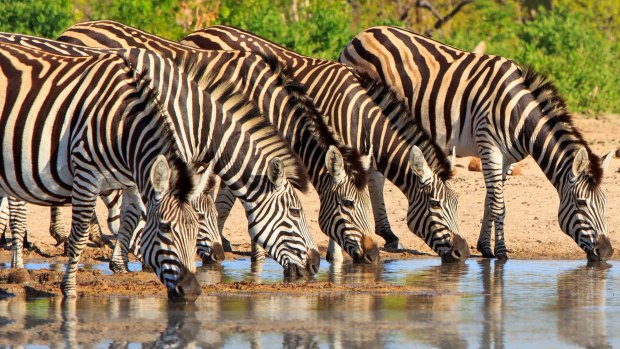
Zebras in Hwange National Park, Zimbabwe.Credit: Shutterstock.com
As our five-seater helicopter flew low over Zimbabwe's Zambezi National Park I spotted the elephants, a splash of rumps and trunks wending through the wetlands. Upstream from Victoria Falls and across the Zambezi River from Zambia, this little-known national park is home to all creatures great and small including lion, leopard, elephant and hippo. I'd tingled in anticipation at the promise of the adventures ahead.
A few hours later I'm on foot following guide Linos Nynoni along a well-worn elephant path, sweating bullets and praying to every known African god that we don't see anything bigger than a warthog.
"Stop," whispers Nynoni, signalling for our small group of six to stay behind. With an armed guide in front and another bringing up the rear we are locked together like a single caterpillar-like entity with a dozen trembling legs.
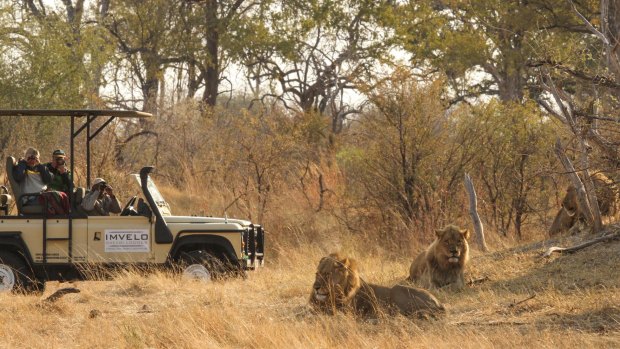
Morning safari at Hwange National Park, Zimbabwe.Credit: Imvelo Safari Lodges
One moment all is calm – the shoulder-high grass fluttering like an ocean of reeds – next, the blades are pulsing with electricity. A flash of colour, a pair of handlebar horns, and the buffalo is gone.
A few years ago this type of safari in Zambezi National Park would not have been possible. Decades of poaching, particularly during the grimmest years of dictator Robert Mugabe's rule, had decimated the park.
When Mugabe resigned as president in late 2017, ending his 37-year rule, mass celebrations broke out in the streets. Ross Kennedy, CEO of Africa Albida Tourism in Victoria Falls, is optimistic about what this means for tourism. Visitors to the area over the past year or so have been about 10 per cent higher than they were the year before and stronger growth is anticipated for 2019, he says.
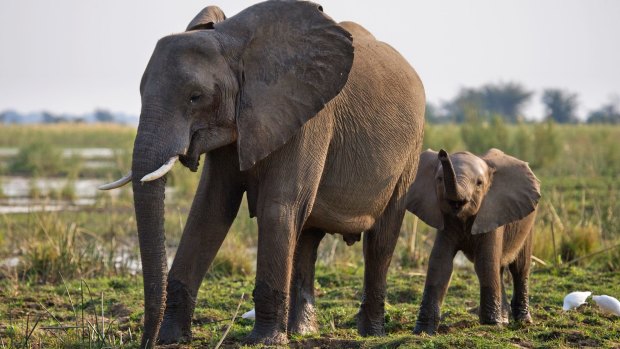
Elephants in Zambezi National Park.Credit: Shutterstock
The good news is that renewed enthusiasm is being felt right across the country.
"It's been incredible to see the demand for travel to Zimbabwe extend to destinations further afield from the standard Vic Falls stopover," says Martin Edwards, general manager of Bench Africa, an Australian company that has been bringing guests to Africa for 50 years. "Off the back of this increased demand, we have introduced a brand new safari circuit which combines Hwange with the iconic Mana Pools National Park. Zimbabwe is definitely open for business!"
When I visit there is a palpable optimism as Mugabe's successor Emmerson Mnangagwa vows to rebuild his crippled country. I'm staying inside the national park at Zambezi Sands River Camp, one of six lodges in Zimbabwe managed by Imvelo Safari Lodges, a company with a strong commitment to community and conservation. Game walks are a new initiative; not a trendy add-on, but a chance for guests to help in the lodge's mission to locate and remove poachers' snares. "Things are improving," says John Laing, manager of Zambezi Sands. "In 2015 we removed 1000 snares, this year we've pulled less than 100."
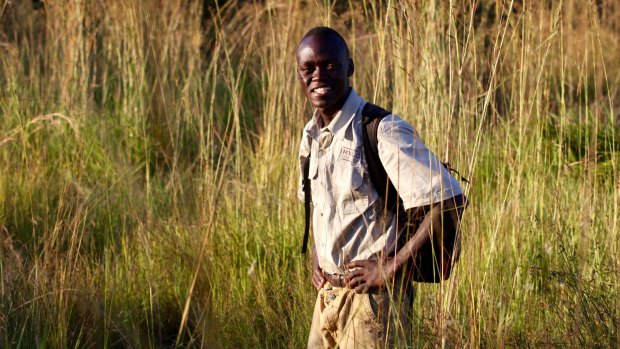
Linos Nynoni from Zambezi sands River Camp leads our foot safari.Credit: Kerry van der Jagt
Laing explains that poachers' snares are simple nooses fashioned out of cable or wire. "Most are set by subsistence farmers from across the river in Zambia," says Laing. "The more eyes we have on the place, the [fewer] snares there'll be."
Since 2015 Laing has watched the wildlife amble, swim, trot and fly back as visitor numbers have increased. Today, the park boasts healthy numbers of buffalo, elephants, giraffe, antelopes, hippos, hyenas and an increasing number of lions.
Over the next two days we enjoy sunrise game drives, pausing to enjoy everything from a tower of gangly giraffes to a pair of fighting dung beetles. When the sun is a fireball overhead we return to our luxury Bedouin-inspired "tents" for a siesta or a dip in our private plunge pool overlooking the Zambezi River. Sunset signals another game drive and sundowners at a scenic waterhole.
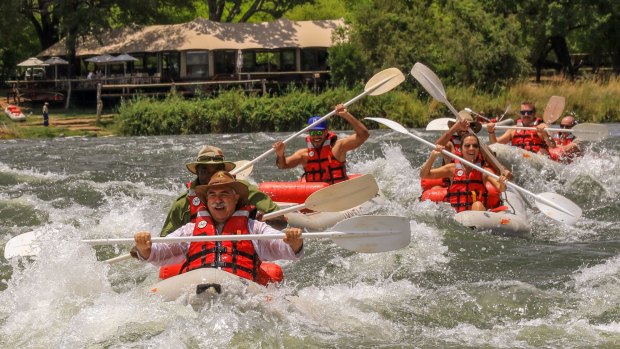
Canoeing the Zambezi River in front of Zambezi Sands River Camp.Credit: Imvelo Safari Lodges
One afternoon we take to the river in canoes, weaving between islands while keeping an eye out for hippos and crocs. After paddling a 14-kilometre section we lash our canoes together and share cold beers, humbled to be here as Zimbabwe takes its first tentative steps forward.
Confidence in the new regime is being felt across numerous sectors. Mavros Safaris, a luxury African safari operator that takes visitors to less-travelled parts of Zimbabwe, is noticing big changes. "November 2017 ushered a new wave of interest in the country for two market segments in particular," says Alexander Mavros. "First time safari travellers choosing Zimbabwe to be a part of this optimistic movement, and an older generation of safari-goers who spent time in Zimbabwe 20 or 30 years ago and have longed to return."
In response to this new optimism, Imvelo Safari Lodges has expanded and refurbished some of its lodges, including restoring a 1950s vintage sleeper train to transport guests from Victoria Falls to its lodges in Hwange National Park. "It's time to bring old-school fun and romance back to safaris," says Mark "Butch" Butcher, managing director of Imvelo Safari Lodges.
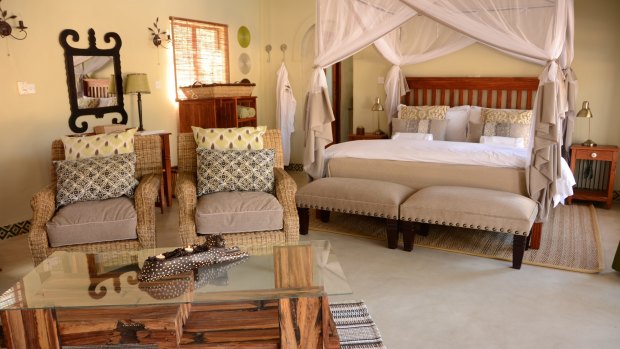
Camelthorn Lodge.Credit: Imvelo Safari Lodges
I'm on the inaugural overnight journey of Stimela Star, the catch-cry "happy days" accompanying every toast. While the phrase is a popular saying in Zimbabwe, with Mugabe's self-serving regime gone it has taken on a deeper meaning.
Butcher knows that for truly happy days, tourism needs to benefit people living adjacent to parks, where human-wildlife conflicts are critical. "We need to prove that wildlife are more valuable alive than dead," he says. . "And that there can be a positive flow-on effect when the animals are protected."
Imvelo has contributed more than $US1.5 million in the past seven years to improve the lives of local people through scholarships, employment, meals, new wells, school buildings and dental clinics. At Imvelo's flagship Camelthorn Lodge, guests are invited to visit Ngamo village to see the improvements first hand.
Imvelo has also been heavily involved in pumping bore water to the pans of Hwange National Park, particularly during the harsh dry season from August to October. To further protect Hwange's wildlife it has developed an anti-poaching unit called The Cobras. The new initiative is comprised of individuals from local communities who work alongside National Park rangers to patrol core areas, remove snares and educate the villagers on wildlife conservation.
Hwange is a conservation success story, with a healthy population of 46,000 elephants, one of the largest herds remaining in Africa. Home to lions, giraffes, zebra, buffalo, wildebeest, leopards, cheetahs and rare African painted wild dogs, Zimbabwe's largest park is starting to get the recognition it deserves.
On my final morning I sample another new initiative, a partnership between Hwange Horseback Safaris and Imvelo to offer horse riding on the Ngamo Plains. Calling on my rusty riding skills I mount Flight, an ex-polo pony that is nimble and responsive, just what is needed in case of close encounters of the wildlife kind. For the next two hours we are one, cantering through lily ponds and trotting across open savannah, the recent rains bringing a rejuvenation and promise that could stand for Zimbabwe as a whole.
FIVE MORE ZIMBABWEAN WILDLIFE EXPERIENCES
BATOKA GORGE
Home to nesting black eagles and lanner falcons, Batoka Gorge on the Zambezi River is a 30-minute drive from Victoria Falls town. Stay in tents at Little Gorges Lodge where concession fees and royalties help support locals schools. See imvelosafarilodges.com
MANA POOLS NATIONAL PARK
This UNESCO World Heritage-listed collection of pools, pans and springs in northern Zimbabwe offers world-class wildlife viewing. See zimparks.org
SAPI PRIVATE CONCESSION
A former hunting concession has been converted into a reserve for low-volume, low-impact tourism. See greatplainsconservation.com
GONAREZHOU NATIONAL PARK
Meaning "the place of many elephants" this national park in the south-east of the country is on the comeback thanks to stringent anti-poaching measures. See zimparks.org
LAKE KARIBA
Created after the completion of Kariba Dam in 1959, this man-made lake offers birding and game viewing as well as sailing and watersports.
TRIP NOTES
Kerry van der Jagt travelled as a guest of Bench Africa and Imvelo Safari Lodges
Qantas flies from Sydney to Johannesburg (Melbourne passengers must fly to Sydney first) with connecting flights to Victoria Falls. See qantas.com
TOUR
Bench Africa offers an 11-day Wildlife and Waterfall Rail Safari beginning at Zambezi Sands River Camp before travelling on the Stimela Star to Hwange National Park where guests have seven days staying at Camelthorn and Nehimba Lodges. Prices start from $8895 per person, including most meals, local drinks, overnight train and game viewing. Phone 1300 237 422 or see www.benchafrica.com.au
Sign up for the Traveller Deals newsletter
Get exclusive travel deals delivered straight to your inbox. Sign up now.